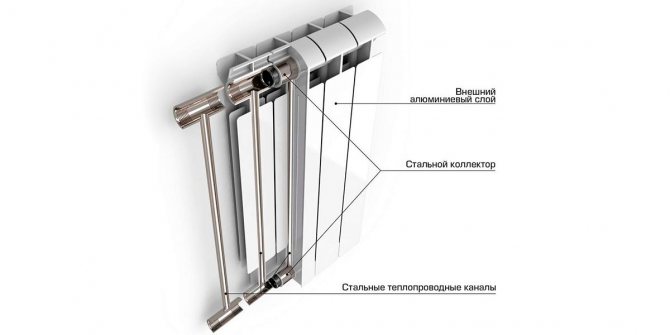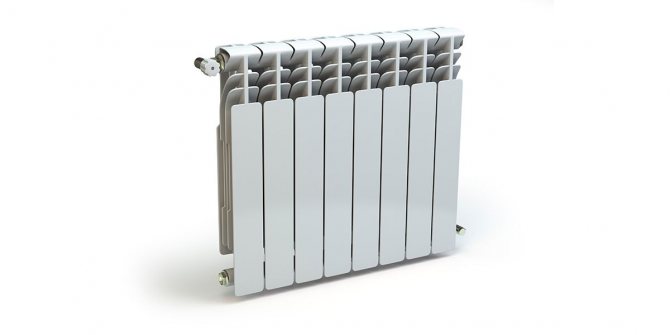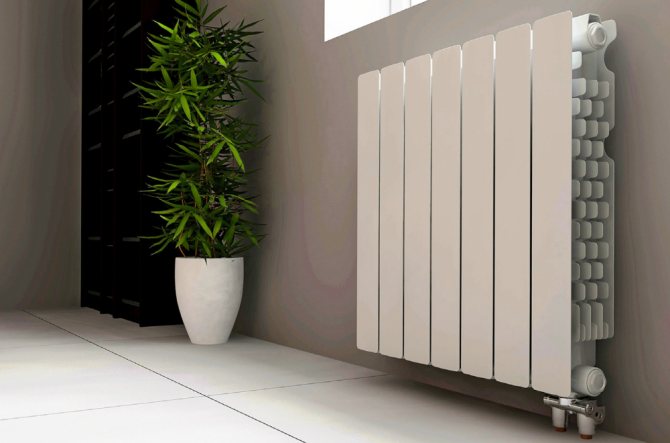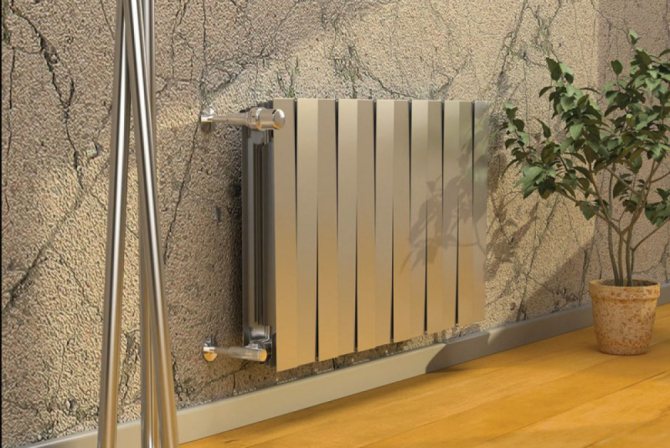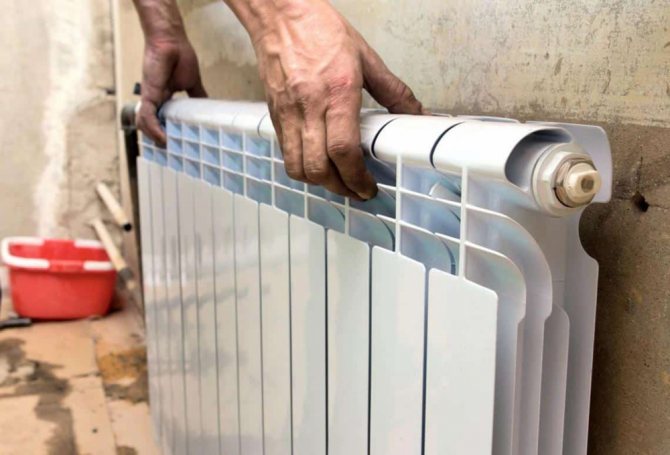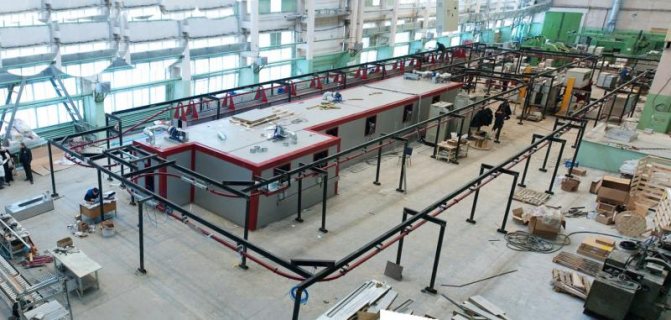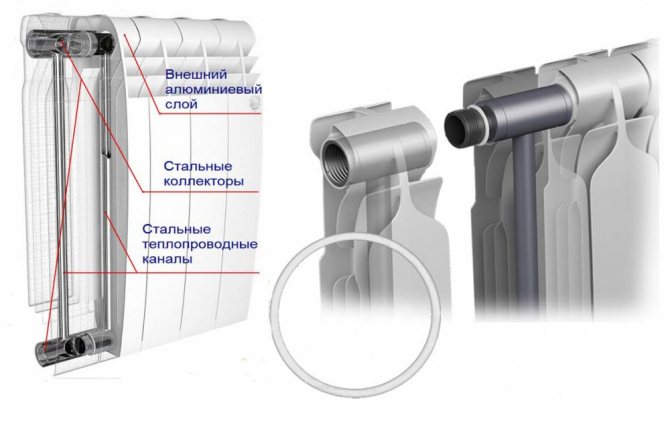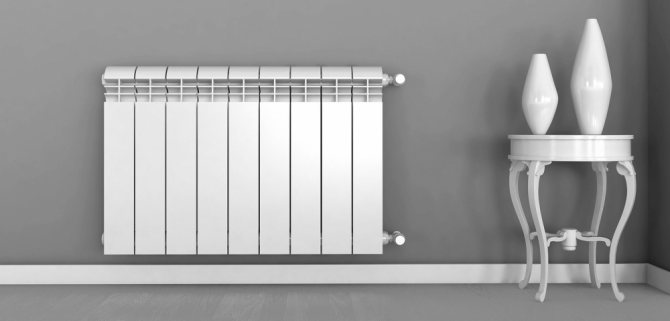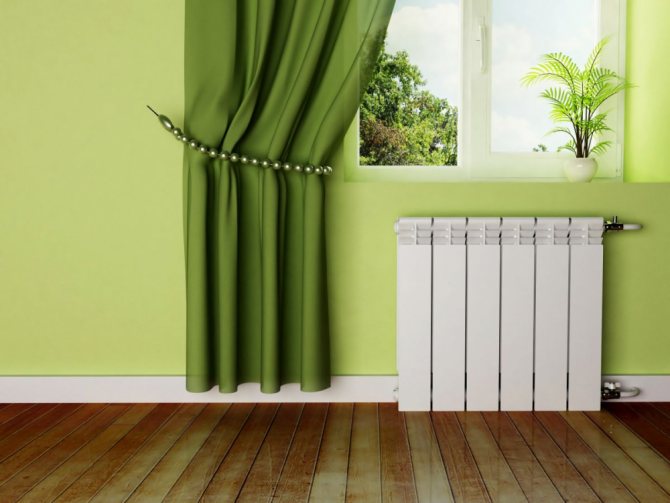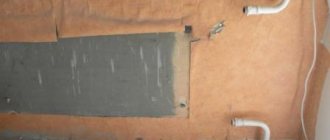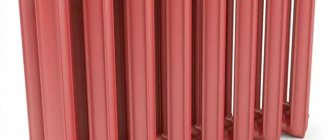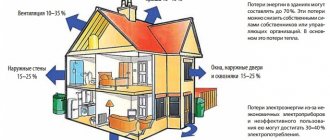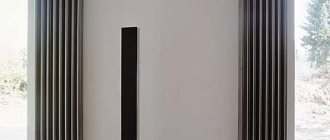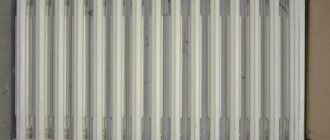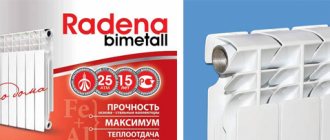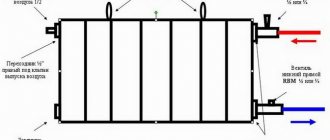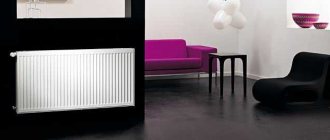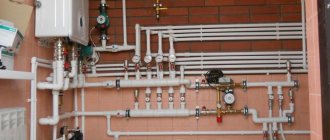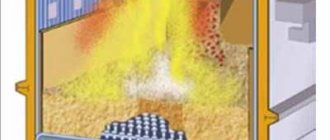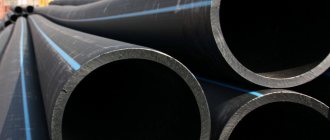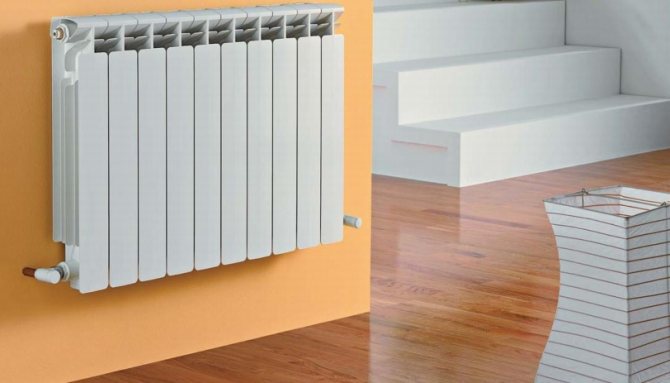
In the construction of any heating system, different types of radiators are used. Any heating system must be designed taking into account the number of radiators and their internal volume. Each radiator section has a certain volume, and when installing the heating system, you need to know for certain the number of sections in the battery. The efficiency and correct operation of the heating system depends on the correct calculation of the number of sections.
What types of radiators are there?
Today the following types of radiators are most commonly used:
- cast iron radiators;
- aluminum alloy radiators;
- bimetallic radiators.
Varieties of heating batteries
Standard
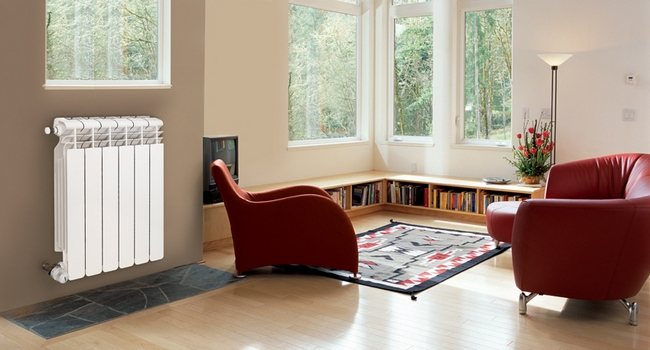

These devices are available in a range of heights, typically from 300 to 750 mm, with the largest range of lengths and configurations in heights from 450 to 600 mm in height. The length ranges from 200 mm to 3 m or more, with the greatest range from 450 mm to 2 m in length.
Panels and convectors
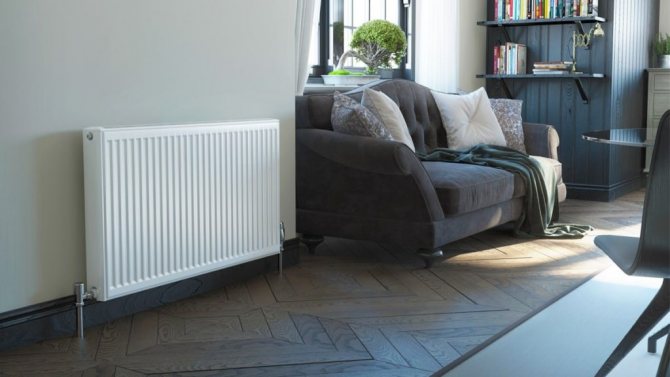

Such radiators usually consist of one or two panels, but sometimes 3-panel ones are found. Modern single-panel radiators have a corrugated panel that forms a series of fins (called "convectors") attached to the rear (wall-facing) side of the panel, which increases the convection power of the battery. These are commonly known as "single convector" (SC). Radiators consisting of two panels with fins stacked on top of each other (with fins in the middle) are known as "dual convector" (DC) radiators. There are also double radiators, consisting of one finned panel and one non-finned panel. The old design radiators consisted of one or two panels without any convection fins.
A traditional standard heat sink has seams at the top, sides, and bottom of each panel (where pressed steel sheets are joined together). Nowadays, most seam batteries are sold with decorative panels installed on the top and sides (the top ones have vents for air circulation), and these are known as "compact" batteries. The top seam radiator alternative uses a single sheet of pressed steel and this sheet is rolled together at the top of the radiator.
Low surface temperature batteries
Most of these radiators are designed so that their radiating surfaces have relatively low temperatures at normal heating system temperatures. They are used wherever there is a risk of burns - most often in child care facilities, nursing homes, hospitals and hospitals.
Designer batteries
There is a huge selection of radiator designs available that can be more pleasing to the eye than their regular counterparts. Some designer batteries are available in tall, narrow configurations that may be suitable for rooms with, for example, narrow walls next to doors, where conventional radiators cannot provide sufficient power with limited wall space available.
Skirting radiators
These devices are usually disguised as skirting boards. The operation of these radiators is similar to the “warm floor” effect, as the user eye does not notice any radiator sections on the walls. Installation of skirting boards allows you to save the interior space of the room.
Heated towel rails
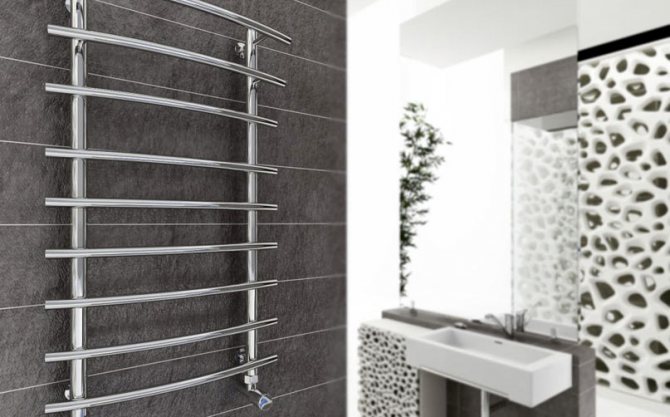

These radiators are specially designed for drying towels, as well as for draining bathtubs and showers.However, the heat output of towel warmers is significantly reduced when covered with towels, and even if they are not covered with towels, towel warmers are able to dissipate much less heat than conventional batteries of a similar size. Usually, heated towel rails are not enough to heat the premises. They are used only in relatively small and well insulated bathrooms. Some towel radiator designs contain a conventional radiator with towel racks above and sometimes on the sides of the radiator. Such devices have the best heat output.
How to calculate the number of sections
For full and optimal heating of the useful volume of living rooms of a country house, apartment or office space, an accurate calculation will be required. To simplify the task, consider the principle of calculation using the example of a 30 m2 housing. If the ceiling height does not exceed 2.7 meters, and the power of each radiator segment is 200 W, then the formula will look like this: 30x100 / 200 = 15. A small one-room apartment will need about 15 ribs located in the kitchen and in the room under the window.
This is how the calculation of sections of bimetallic radiators for uniform heating of rooms with one outer wall looks like in practice. If there are two external capital structures and a pair of window openings, then a 30 percent regulating factor is applied, by which the result is multiplied. We will have to buy three batteries for standard heating, 6 sections each, which will total 18 ribs filled with coolant.
The amount of coolant in the heating battery
Correctly selected volume of coolant in the section allows the heating radiator to work most optimally. The amount of water in the radiator affects not only the operation of the boiler, but also the efficiency of all elements of the heating system. The most rational selection of the rest of the equipment that is included in the heating system also depends on the correct calculation of the volume of water or antifreeze.
The volume of the coolant in the system also needs to be known in order to choose the right expansion tank. For houses with a central heating system, the volume of radiators is not so important, but for autonomous heating systems, the volume of water in the radiator sections needs to be known for certain. You also need to take into account the volume of pipelines of the heating system so that the heating boiler works in the correct mode. There are special tables for calculating the internal volume of pipelines in the heating system. It is only necessary to correctly measure the length of the heating circuit pipes.
Today, the most demanded radiators are made of bimetal and aluminum alloy. The bimetallic radiator section with a height of 300 millimeters has an internal volume of 0.3 l / m, and the section with a height of 500 millimeters has a volume of 0.39 l / m. The same indicators are for the radiator section made of aluminum alloy.
Also, cast iron radiators are still in use. The imported cast iron section, 300 millimeters high, has an internal volume of 0.5 l / m, and the same section with a height of 500 mm already has an internal volume of 0.6 l / m. Domestic-made cast iron batteries with a height of 300 mm have an internal volume of 3 l / m, and a section with a height of 500 mm has a volume of 4 l / m.
Water or antifreeze
Ordinary water is most often used as a coolant, but antifreeze and distillate are also used. Antifreeze is used only if the residence in the house is not permanent. Antifreeze is needed when the heating system does not work during the winter. Using antifreeze as a coolant is much more expensive than using ordinary water. In order not to spend extra money when using antifreeze as a coolant, you need to know exactly the volume of the heating system.The number of radiator sections should be counted, and the volume of the radiators should be calculated using the above parameters. The volume of the pipeline is determined using a special table. But for this, you first need to measure the length of the pipes with an ordinary tape measure.
At the end of the calculations, the volume of pipelines and the volume of heating radiators are added together, and already on the basis of these data, the required amount of antifreeze is purchased. Also, this data will be useful for determining the amount of water that will be used in the heating system. This information will allow the most flexible setting of the boiler, as well as other elements of the heating circuit.
Dimensions of aluminum radiators of various manufacturers and their models
The tables below show both the size of the aluminum heat sink section and the dimensions of the complete heat sinks.
ROVALL aluminum radiators
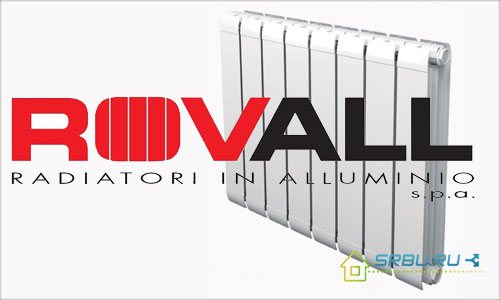

This company, which is part of the Sira Group, makes aluminum batteries with a distance between the collectors of 50, 20 and 35 cm.The kit for their installation (which is purchased separately) must include adapters, plugs, nipples with gaskets (for connecting sections), brackets for wall mounting and a Mayevsky crane.
Country of origin: Italy.
Main settings:
- Maximum working pressure - 20 bar.
- The pressure when testing the device is 37.5 bar.
- The water temperature limit is 110 ° C.
Characteristics of Rovall Alux 200 - distance between axles 200 mm:
| Model | Dimensions (W / G / D), mm | Power of the entire radiator, W | Number of sections |
| ALUX 200/1 | 245 / 100 / 80 | 92 | 1 |
| ALUX 200/4 | 245 / 100 / 320 | 368 | 4 |
| ALUX 200/6 | 245 / 100 / 480 | 552 | 6 |
| ALUX 200/8 | 245 / 100 / 640 | 736 | 8 |
| ALUX 200/10 | 245 / 100 / 800 | 920 | 10 |
| ALUX 200/12 | 245 / 100 / 960 | 1104 | 12 |
| ALUX 200/14 | 245 / 100 / 1120 | 1288 | 14 |
| ALUX 200/16 | 245 / 100 / 1280 | 1472 | 16 |
* All data are taken from the official sources of the manufacturers.
Characteristics of Rovall Alux 350 - distance between axles 350 mm:
| Model | Dimensions (W / G / D), mm | Power of the entire radiator, W | Number of sections |
| ALUX 350/1 | 395 / 100 / 80 | 138 | 1 |
| ALUX 350/44 | 395 / 100 / 320 | 552 | 4 |
| ALUX 350/6 | 395 / 100 / 480 | 828 | 6 |
| ALUX 350/8 | 395 / 100 / 640 | 1104 | 8 |
| ALUX 350/10 | 395 / 100 / 800 | 1380 | 10 |
| ALUX 350/12 | 395 / 100 / 960 | 1656 | 12 |
| ALUX 350/14 | 395 / 100 / 1120 | 1936 | 14 |
| ALUX 350/16 | 395 / 100 / 1280 | 2208 | 16 |
* All data are taken from the official sources of the manufacturers.
Characteristics of Rovall Alux 500 - distance between axles 500 mm:
| Model | Dimensions (W / G / D), mm | Power of the entire radiator, W | Number of sections |
| ALUX 500/1 | 545 x 100 x 80 | 179 | 1 |
| ALUX 500/4 | 545 x 100 x 320 | 716 | 4 |
| ALUX 500/6 | 545 x 100 x 480 | 1074 | 6 |
| ALUX 500/8 | 545 x 100 x 640 | 1432 | 8 |
| ALUX 500/10 | 545 x 100 x 800 | 1790 | 10 |
| ALUX 500/12 | 545 x 100 x 960 | 2148 | 12 |
| ALUX 500/14 | 545 x 100 x 1120 | 2506 | 14 |
| ALUX 500/16 | 545 x 100 x 1280 | 2840 | 16 |
* All data are taken from the official sources of the manufacturers.
Aluminum radiators Climatic Control Corporation LLP
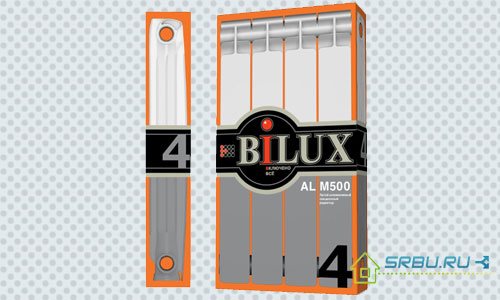

The brainchild of this company are BiLUX AL radiators with excellent heat output, which are made taking into account all the nuances of individual heating systems. Their surface area is very significant, and the section of the vertical pipe is calculated optimally. The factory for the production of these radiators is located in China. The distance between the axes of the collectors can be 30 cm (BiLUX AL M 300) or 50 cm (BiLUX AL M 500).
During the manufacturing process, the die-cast tops are connected to the bottom, which is made using a special welding technology. Once assembled, the batteries are chemically and mechanically processed. Then they are tested, checking how tight and strong they are. They paint the batteries in several steps. After cleaning, they are exposed to an electrostatic field. At this time, epoxy enamel is sprayed on. Then, by heating to a high temperature, the surface of the product is polymerized.
The ends of BiLUX AL radiators have a special design that allows using a special ring as a gasket. The material from which it is made completely seals the joints. In this case, the nipples are cadmium-plated. Leaks are absolutely excluded. No matter how many times the battery sections are moved, it is as simple as possible to do this.
Country of origin: United Kingdom
Main settings:
- Working pressure limit - 16 bar.
- Test pressure limit - 24 bar.
- pressure capable of breaking the battery - 48 bar.
BiLUX AL characteristics:
| Model | Distance between axles, mm | Dimensions (W / G / D), mm | Power of the entire radiator, W | Number of sections |
| BiLUX AL M 500 | 500 | 570 / 75-80 / 75 | 180 | 1 |
| BiLUX AL M 300 | 300 | 370 / 75-80 / 75 | 128 | 1 |
* All data are taken from the official sources of the manufacturers.
Fondital aluminum radiators


This company produces Calidor Super radiators. They are adapted for the Russian climate, as well as for the CIS countries. The production takes into account not only the European standards EN 442, but also the Russian ones - GOST R RU.9001.5.1.9009. Manufacturing method - high pressure casting. Coloring takes place in two stages. First, a protective layer of enamel is applied using anaphoresis, and then powder enamel gives beauty to the product. Mounting kit sold separately. These are Mayevsky's crane, blind plugs, adapters and brackets.
Country of origin: Italy.
Distance between axles:
- 35 cm - Model S4 with 9.7 cm section depth and four side ribs.
- 50 cm - Both the S4 model (with four ribs and 9.7 cm deep) and the lighter S3 model (with three ribs and 9.6 cm deep).
Main settings:
- Working pressure limit - 16 bar.
- Burst pressure limit - 60 bar. A pressure test of 24 bar is carried out at every stage of production.
- The water temperature limit is 120 ° C.
Characteristics of Calidor Super 350 S4 radiators - center-to-center distance 350 mm, section has a depth of 96 mm. and 4 side ribs:
| Model | Dimensions (W / G / D), mm | Power of the entire radiator, W | Number of sections |
| Calidor S 350/1 | 428 / 96 / 80 | 145 | 1 |
| Calidor S 350/4 | 428 / 96 / 320 | 582 | 4 |
| Calidor S 350/5 | 428 / 96 / 400 | 727 | 5 |
| Calidor S 350/6 | 428 / 96 / 480 | 873 | 6 |
| Calidor S 350/7 | 428 / 96 / 560 | 1018 | 7 |
| Calidor S 350/8 | 428 / 96 / 640 | 1163 | 8 |
| Calidor S 350/9 | 428 / 96 / 720 | 1309 | 9 |
| Calidor S 350/10 | 428 / 96 / 800 | 1454 | 10 |
| Calidor S 350/11 | 428 / 96 / 880 | 1600 | 11 |
| Calidor S 350/12 | 428 / 96 / 960 | 1745 | 12 |
| Calidor S 350/13 | 428 / 96 / 1040 | 1891 | 13 |
| Calidor S 350/14 | 428 / 96 / 1120 | 2036 | 14 |
* All data are taken from the official sources of the manufacturers.
Dimensions and characteristics Calidor Super 500 S4 - center distance 500 mm, section with 4 side ribs and 96 mm depth:
| Model | Dimensions (W / G / D), mm | Power of the entire radiator, W | Number of sections |
| Calidor S 500/1 | 578 / 96 / 80 | 192 | 1 |
| Calidor S 500/4 | 578 / 96 / 320 | 770 | 4 |
| Calidor S 500/5 | 578 / 96 / 400 | 962 | 5 |
| Calidor S 500/6 | 578 / 96 / 480 | 1155 | 6 |
| Calidor S 500/7 | 578 / 96 / 560 | 1347 | 7 |
| Calidor S 500/8 | 578 / 96 / 640 | 1539 | 8 |
| Calidor S 500/9 | 578 / 96 / 720 | 1732 | 9 |
| Calidor S 500/10 | 578 / 96 / 800 | 1924 | 10 |
| Calidor S 500/11 | 578 / 96 / 880 | 2117 | 11 |
| Calidor S 500/12 | 578 / 96 / 960 | 2309 | 12 |
| Calidor S 500/13 | 578 / 96 / 1040 | 2502 | 13 |
| Calidor S 500/14 | 578 / 96 / 1120 | 2694 | 14 |
* All data are taken from the official sources of the manufacturers.
Dimensions and characteristics Calidor Super 500 S3 - 500 mm center distance. and the section has three side ribs and a depth of 100 mm:
| Model | Dimensions (W / G / D), mm | Power of the entire radiator, W | Number of sections |
| Calidor S 500/1 | 578 / 100 / 80 | 178 | 1 |
| Calidor S 500/4 | 578 / 100 / 320 | 712 | 4 |
| Calidor S 500/5 | 578 / 100 / 400 | 890 | 5 |
| Calidor S 500/6 | 578 / 100 / 480 | 1068 | 6 |
| Calidor S 500/7 | 578 / 100 / 560 | 1246 | 7 |
| Calidor S 500/8 | 578 / 100 / 640 | 1424 | 8 |
| Calidor S 500/9 | 578 / 100 / 720 | 1602 | 9 |
| Calidor S 500/10 | 578 / 100 / 800 | 1780 | 10 |
| Calidor S 500/11 | 578 / 100 / 880 | 1958 | 11 |
| Calidor S 500/12 | 578 / 100 / 960 | 2136 | 12 |
| Calidor S 500/13 | 578 / 100 / 1040 | 2314 | 13 |
| Calidor S 500/14 | 578 / 100 / 1120 | 2478 | 14 |
* All data are taken from the official sources of the manufacturers.
Aluminum radiators from Faral S.p.A.
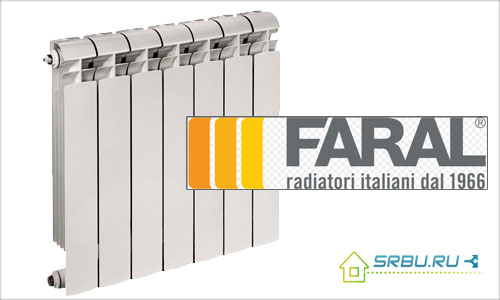

This company makes especially for Russia especially durable radiators FARAL Green HP, which withstand 16 atmospheres of operating pressure. They are produced by injection molding. Both inside and outside they are covered with a protective zirconium layer that penetrates deep into the surface of the aluminum and does not wash off. Therefore, no gas emission occurs when the battery comes into contact with water. Electrochemical corrosion is excluded.
The depth of the FARAL Green HP batteries is 8 cm, and the FARAL Trio HP is 9.5 cm.And the distance between the axes of the manifolds is 35 or 50 cm.The separately purchased mounting kit includes a standard air vent valve, adapters with plugs and brackets, silicone gaskets and self-tapping screws with plugs.
Country of origin: Italy.
Main settings:
- Working pressure limit - 16 bar.
- The test pressure limit is 24 bar.
- The water temperature limit is 110 ° C.
Dimensions and characteristics of radiators FARAL Green HP 350 - distance between axles 350 mm:
| Model | Dimensions (W / G / D), mm | Power of the entire radiator, W | Number of sections |
| FARAL Green HP 350/1 | 430 / 80 / 80 | 134 | 1 |
| FARAL Green HP 350/4 | 430 / 80 / 320 | 544 | 4 |
| FARAL Green HP 350/6 | 430 / 80 / 480 | 816 | 6 |
| FARAL Green HP 350/8 | 430 / 80 / 640 | 1088 | 8 |
| FARAL Green HP 350/10 | 430 / 80 / 800 | 1360 | 10 |
| FARAL Green HP 350/12 | 430 / 80 / 960 | 1632 | 12 |
| FARAL Green HP 350/14 | 430 / 80 / 1120 | 1904 | 14 |
* All data are taken from the official sources of the manufacturers.
Dimensions and characteristics of radiators FARAL Green HP 500 - distance between axles 500 mm:
| Model | Dimensions (W / G / D), mm | Power of the entire radiator, W | Number of sections |
| FARAL Green HP 500/1 | 580 / 80 / 80 | 180 | 1 |
| FARAL Green HP 500/4 | 580 / 80 / 320 | 720 | 4 |
| FARAL Green HP 500/5 | 580 / 80 / 400 | 900 | 5 |
| FARAL Green HP 500/6 | 580 / 80 / 480 | 1080 | 6 |
| FARAL Green HP 500/7 | 580 / 80 / 560 | 1260 | 7 |
| FARAL Green HP 500/8 | 580 / 80 / 640 | 1440 | 8 |
| FARAL Green HP 500/10 | 580 / 80 / 800 | 1800 | 10 |
| FARAL Green HP 500/12 | 580 / 80 / 960 | 2160 | 12 |
| FARAL Green HP 500/14 | 580 / 80 / 1120 | 2520 | 14 |
* All data are taken from the official sources of the manufacturers.
Dimensions and characteristics of radiators FARAL Trio HP 500 - center distance 500 mm:
| Model | Dimensions (W / G / D), mm | Power of the entire radiator, W | Number of sections |
| FARAL Trio HP 500/1 | 580 / 95 / 80 | 212 | 1 |
| FARAL Trio HP 500/4 | 580 / 95 / 320 | 848 | 4 |
| FARAL Trio HP 500/5 | 580 / 95 / 400 | 1060 | 5 |
| FARAL Trio HP 500/6 | 580 / 95 / 480 | 1272 | 6 |
| FARAL Trio HP 500/7 | 580 / 95 / 560 | 1484 | 7 |
| FARAL Trio HP 500/8 | 580 / 95 / 640 | 1696 | 8 |
| FARAL Trio HP 500/10 | 580 / 95 / 800 | 2120 | 10 |
| FARAL Trio HP 500/21 | 580 / 95 / 960 | 2544 | 12 |
| FARAL Trio HP 500/14 | 580 / 95 / 1120 | 2968 | 14 |
* All data are taken from the official sources of the manufacturers.
Dimensions and characteristics of radiators FARAL Trio HP 350 - center distance 350 mm:
| Model | Dimensions (W / G / D), mm | Power of the entire radiator, W | Number of sections |
| FARAL Trio HP 350/1 | 430 / 95 / 80 | 151 | 1 |
| FARAL Trio HP 350/4 | 430 / 95 / 320 | 604 | 4 |
| FARAL Trio HP 350/6 | 430 / 95 / 480 | 906 | 6 |
| FARAL Trio HP 350/8 | 430 / 95 / 640 | 1208 | 8 |
| FARAL Trio HP 350/10 | 430 / 95 / 800 | 1510 | 10 |
| FARAL Trio HP 350/12 | 430 / 95 / 960 | 1812 | 12 |
| FARAL Trio HP 350/14 | 430 / 95 / 1120 | 2114 | 14 |
* All data are taken from the official sources of the manufacturers.
Aluminum radiators Global
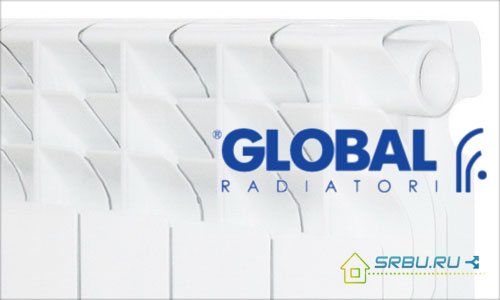

The radiators of the same name from this company can be used both in an apartment and in a private house. They are distinguished by their elegance and originality of design. The most popular models are Global ISEO and Global VOX. All are available with 35cm or 50cm spacing. Mounting kit (sold separately) is standard.
Country of origin: Italy.
Main settings:
- Maximum working pressure - 16 bar.
- Pressing pressure - 24 bar.
- The maximum hot water temperature is 110 ° C.
Dimensions and characteristics of radiators Global VOX 350 - center distance 350 mm:
| Model | Dimensions (W / G / D), mm | Power of the entire radiator, W | Number of sections |
| Global VOX 350/1 | 440 / 95 / 80 | 145 | 1 |
| Global VOX 350/4 | 440 / 95 / 320 | 580 | 4 |
| Global VOX 350/6 | 440 / 95 / 480 | 870 | 6 |
| Global VOX 350/8 | 440 / 95 / 640 | 1160 | 8 |
| Global VOX 350/10 | 440 / 95 / 800 | 1450 | 10 |
| Global VOX 350/12 | 440 / 95 / 960 | 1740 | 12 |
| Global VOX 350/14 | 440 / 95 / 1120 | 2030 | 14 |
* All data are taken from the official sources of the manufacturers.
Dimensions and characteristics of Global VOX 500 - distance between axles 500 mm:
| Model | Dimensions (W / G / D), mm | Power of the entire radiator, W | Number of sections |
| Global VOX 500/1 | 590 / 95 / 80 | 193 | 1 |
| Global VOX 500/4 | 590 / 95 / 320 | 772 | 4 |
| Global VOX 500/6 | 590 / 95 / 480 | 1158 | 6 |
| Global VOX 500/8 | 590 / 95 / 640 | 1544 | 8 |
| Global VOX 500/10 | 590 / 95 / 800 | 1930 | 10 |
| Global VOX 500/12 | 590 / 95 / 960 | 2316 | 12 |
| Global VOX 500/14 | 590 / 95 / 1120 | 2702 | 14 |
* All data are taken from the official sources of the manufacturers.
Dimensions and characteristics of Global ISEO radiators - center-to-center distance 350 mm:
| Model | Dimensions (W / G / D), mm | Power of the entire radiator, W | Number of sections |
| Global ISEO 350/1 | 432 / 80 / 80 | 134 | 1 |
| Global ISEO 350/4 | 432 / 80 / 320 | 536 | 4 |
| Global ISEO 350/6 | 432 / 80 / 480 | 804 | 6 |
| Global ISEO 350/8 | 432 / 80 / 640 | 1072 | 8 |
| Global ISEO 350/10 | 432 / 80 / 800 | 1340 | 10 |
| Global ISEO 350/12 | 432 / 80 / 960 | 1608 | 12 |
| Global ISEO 350/14 | 432 / 80 / 1120 | 1876 | 14 |
* All data are taken from the official sources of the manufacturers.
Dimensions and characteristics of Global ISEO radiators - center distance 500 mm:
| Model | Dimensions (W / G / D), mm | Power of the entire radiator, W | Number of sections |
| Global ISEO 500/1 | 582 / 80 / 80 | 181 | 1 |
| Global ISEO 500/4 | 582 / 80 / 320 | 724 | 4 |
| Global ISEO 500/6 | 582 / 80 / 480 | 1086 | 6 |
| Global ISEO 500/8 | 582 / 80 / 640 | 1448 | 8 |
| Global ISEO 500/10 | 582 / 80 / 800 | 1810 | 10 |
| Global ISEO 500/12 | 582 / 80 / 960 | 2172 | 12 |
| Global ISEO 500/14 | 582 / 80 / 1120 | 2534 | 14 |
* All data are taken from the official sources of the manufacturers.
Torex aluminum radiators
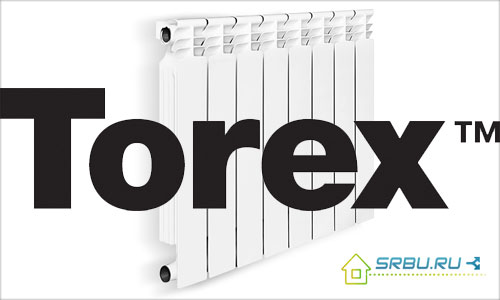

The company produces Torex aluminum sectional batteries made by casting. Their difference is the extraordinary design of the frontal part, which forms interesting light transitions. For models with a center distance of 35 cm, the depth is 7.8 cm, and with a distance of 50 cm, batteries are made with a depth of 7.8 and 7 cm. They can have an even number of sections - from 6 to 14. The mounting kit is not included in the price of the battery.
Country of origin: Italy
Main settings:
- Working pressure limit - 16 bar.
- The test pressure limit is 24 bar.
- The temperature limit is 110 ° C.
- The optimum pH of water is 7-8 (6.5 - 8.5 is possible).
Dimensions and characteristics of Torex B 350 radiators - center distance - 350 mm:
| Model | Dimensions (W / G / D), mm | Power of the entire radiator, W | Number of sections |
| Torex B 350/1 | 420 / 78 / 80 | 130 | 1 |
| Torex B 350/6 | 420 / 78 / 480 | 720 | 6 |
| Torex B 350/8 | 420 / 78 / 640 | 1040 | 8 |
| Torex B 350/10 | 420 / 78 / 800 | 1300 | 10 |
| Torex B 350/12 | 420 / 78 / 960 | 1560 | 12 |
| Torex B 350/14 | 420 / 78 / 1120 | 1820 | 14 |
* All data are taken from the official sources of the manufacturers.
Dimensions and characteristics of Torex B 500 - center distance - 500 mm:
| Model | Dimensions (W / G / D), mm | Power of the entire radiator, W | Number of sections |
| Torex B 500/1 | 570 / 78 / 80 | 172 | 1 |
| Torex B 500/6 | 570 / 78 / 480 | 1032 | 6 |
| Torex B 500/8 | 570 / 78 / 640 | 1376 | 8 |
| Torex B 500/10 | 570 / 78 / 800 | 1720 | 10 |
| Torex B 500/12 | 570 / 78 / 960 | 2064 | 12 |
| Torex B 500/14 | 570 / 78 / 1120 | 2408 | 14 |
* All data are taken from the official sources of the manufacturers.
Dimensions and characteristics of Torex C 500 radiators - center distance - 500 mm:
| Model | Dimensions (W / G / D), mm | Power of the entire radiator, W | Number of sections |
| Torex C 500/1 | 570 / 70 / 75 | 198 | 1 |
| Torex C 500/6 | 570 / 70 / 450 | 1188 | 6 |
| Torex C 500/8 | 570 / 70 / 600 | 1584 | 8 |
| Torex C 500/10 | 570 / 70 / 750 | 1980 | 10 |
| Torex C 500/12 | 570 / 70 / 900 | 2376 | 12 |
| Torex C 500/14 | 570 / 70 / 1050 | 2772 | 14 |
* All data are taken from the official sources of the manufacturers.
Rifar aluminum radiators
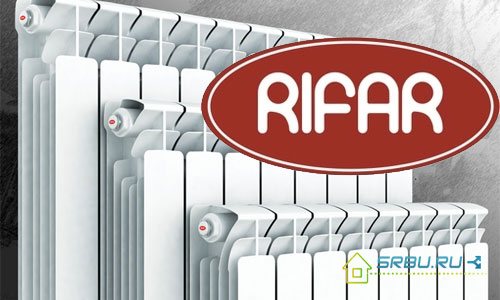

The company produces aluminum radiators of BASE models with a center distance of 500, 350 and 200 mm, ALP models, which have an improved appearance and improved heat transfer due to their design, a center distance of 500 mm. Alum models are specially designed radiators that can be used not only in conventional heating systems, but also as an oil-fired electric heater. The manufacturer also has its own unique development of Flex radiators, the main advantage of which is that the radiator can be given the required radius of curvature.
Main characteristics:
- Working pressure no more than 20 atm;
- The maximum temperature of the coolant is 135 0 С;
- pH of water 7 - 8.5;
Dimensions and characteristics of radiators Rifar Base - radiators are serially produced with the number of sections from 4 to 14:
| Center distance (mm) | Dimensions (W / G / D), mm | Power of the entire radiator, W | Number of sections |
| 200 | 261 / 100 / 80 | 104 | 1 |
| 350 | 415 / 90 80 | 136 | 1 |
| 500 | 570 / 100 / 80 | 204 | 1 |
Dimensions and characteristics of radiators Rifar Alp 500 - radiators are serially produced with the number of sections from 4 to 14:
| Center distance (mm) | Dimensions (W / G / D), mm | Power of the entire radiator, W | Number of sections |
| 500 | 570 / 75 / 81 | 191 | 1 |
Dimensions and characteristics of radiators Rifar Alum - radiators are serially produced with the number of sections from 4 to 14:
| Center distance (mm) | Dimensions (W / G / D), mm | Power of the entire radiator, W | Number of sections |
| 500 | 565 / 90 80 | 183 | 1 |
| 350 | 415 / 90 / 80 | 139 | 1 |
Average data
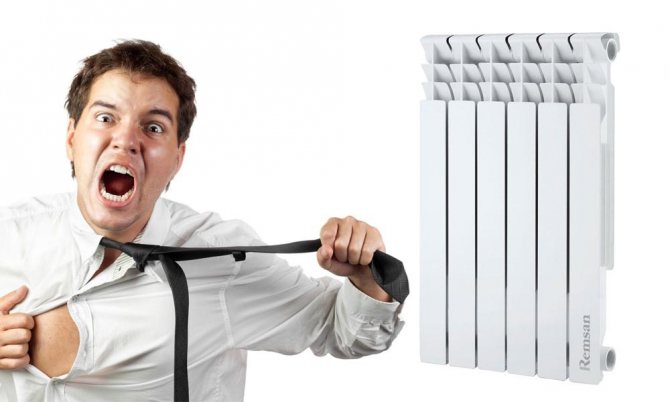

If for some reason the user cannot determine the exact volume of water or antifreeze in heating radiators, then you can use the averaged data that are applicable to heating radiators of one type or another. If, say, we take a 22 or 11 type panel radiator, then for every 10 cm of this heating device there will be 0.5-0.25 liters of coolant.
If you need to determine "by eye" the volume of a section of a cast-iron radiator, then for Soviet samples the volume will range from 1.11 to 1.45 liters of water or antifreeze. If imported cast iron sections are used in the heating system, then such a section has a capacity from 0.12 to 0.15 liters of water or antifreeze.
There is another way to determine the internal volume of the radiator section - to close the lower necks, and pour water or antifreeze into the section through the upper ones - to the top. But this does not always work, since aluminum alloy radiators have a rather complex internal structure. In such a design, it is not so easy to remove air from all internal cavities, therefore this method of measuring the internal volume for aluminum radiators cannot be considered accurate.
How to correctly calculate the heat transfer of equipment
The calculation method is based on the current building codes. To heat 1 m2 of the area of an office or warehouse, a room in an apartment, 100 W of heat is consumed. The heat transfer of each segment is indicated in the passport for Rommer bimetallic heating radiators or another trademark of your choice. If the design capacity is divided by the unit section rate, the result is the number of ribs in a monolithic or prefabricated battery structure.
Accelerated calculation of the power of each section does not require special skills and laborious calculations using formulas. A single segment of the bimetallic battery increases heat transfer by 10% when compared to traditional cast iron options. The small power reserve is compensated for by layers that will appear in the future on the inner walls of the radiator. With the help of taps-regulators of the supply of the volume of the coolant, it is possible to control the temperature in the room.
Correct calculation
You also need to take into account the fact that the heat exchanger of the heating boiler also contains a certain amount of heat carrier. The heat exchanger of a wall-mounted heating boiler can hold from 3 to 6 liters of water, and floor heating devices can hold from 9 to 30 liters.
Having found out for certain the internal volume of all heating radiators, pipelines and a heat exchanger, you can proceed to the selection of an expansion tank. This element of the heating system is very important, since it depends on it to maintain the optimal pressure in the heating circuit.
Dimensions of bimetallic batteries
The height of the device changes in proportion to the increase in the distance between the horizontal channels. The standard height parameters are 20.35 and 50 centimeters.
The dimensions of bimetallic batteries also depend on the manufacturer. Let's look at the most popular sizes of heating devices in the ratio (height * depth * width in centimeters):
- Italian model style 350 - 42.5 * 8 * 8 cm, and style 500 - 40 * 8 * 7.7 cm;
- German batteries Tenrad product brand Tenrad 350 - 40 * 8 * 7.7 cm, and 500 - 55 * 8 * 7.7 cm;
- Ukrainian radiators Altermo model LRB 500 - 57.5 * 8.2 * 8 cm and RIO 500 - 57 * 8.2 * 8 cm;
- Products of the Chinese manufacturer model Grandini 350 - 43 * 8 * 8.2 cm and 500 58 * 8 * 8 cm.
Many manufacturers indicate the center distance in the model brand, the mounting height will depend on the device specification. The width of the battery depends on the number of sections. For models with 6 sections 48 centimeters, with 10 sections - 80 centimeters.
Output
The accurate determination of the total volume of the heating system determines its correct operation and efficiency, as well as the operation in optimal mode of other elements of the system. The most important thing in the correct determination of the volume of the heating circuit is that each boiler is designed for a certain volume of the heating medium. If the volume of the heating system is excessive, then the boiler will work continuously. This will significantly reduce the service life of the heating device, and entail unplanned costs. The volume of the heating circuit must be correctly calculated.
Selection of bimetallic heating radiators
When choosing bimetallic batteries, you should pay attention to a number of criteria on which the operating efficiency will depend.
More information about the manufacturers of bimetallic radiators can be found here
Design
As already noted, radiators can be monolithic and sectional. In order to choose the most optimal option for a specific heating system, you need to know what the operating pressure is in the system. If it is exposed to powerful water hammer, then it is better to give favor to monolithic models. In all other cases, it is recommended to purchase sectional ones, since they are much cheaper.
To get a more reliable device, you should know that there are two types. The first type is made of a steel frame, the other is supplied only with steel-reinforced channels through which the coolant moves.
Batteries belonging to the first type are characterized by greater strength and reliability. In such structures, the coolant does not come into contact with the aluminum alloy, as a result of which the risk of corrosion is minimal.
The main features that characterize the first type are weight and cost. They are produced by such companies: Royal Thermo BiLiner, Global Style, Rifar (Monolit model) and the domestic company Santekhprom BM.
Another type is called semi-metal radiators. The main characteristics of such devices are: high heat transfer and lower price. The most popular brands are Gordi, Sira and Rifar, excluding the Monolit model.
Center distance
Most of the manufactured models of bimetallic radiators are equally functional. However, the distance between the axles varies between models. Standard indicators of the distance between the axles: 35 and 50 cm.
You can find radiators in which the gap is 20 cm, this length is considered to be the minimum. Batteries with this distance are produced by the companies: Sira, BiLUX and RIFAR. The maximum distance is 80 cm, such models are available from the manufacturer Sira.
Manufacturing material
It is important that the radiator withstands the effects of an aggressive environment well if the coolant is not of high quality and contains a large amount of alkali and acidity. This is mainly the case for batteries in apartment buildings.
Also:
- It is important that the inner channels are made of the same metal, preferably stainless steel.
- The wall thickness of the inner pipe should be 3-3.5 mm.
- The quality and elasticity of the gaskets play a very important role. It is they that affect the reliability of the connections, therefore, usually rubber or silicone acts as a material for them. To check the quality of the O-ring, simply bend it with your fingers. If the gasket is stiff and inelastic, then this indicates its poor quality.
- If the radiator is sectional, then here you should pay attention to the nipples. It is important that they are made of high quality steel. The low quality of these parts is evidenced by the softness of the metal. If it is of poor quality, then the hooks for the key will definitely break off and in this case the nipple will need to be sawed with a grinder and parts of it removed from the holes in the sections.
- The front width of the radiator fin must be more than 70 cm.If this indicator is lower, then this will affect the heat transfer of the radiator in the negative direction. The most optimal ratio of the section size to the section is 80 * 80 mm. With such indicators, heat transfer will definitely be high.
- The thickness of the protruding ribs is also indicative of quality. This indicator should be no lower than 1 mm.
Guarantee
The warranty period also indicates the quality of the product. If the manufacturer gives a service life of only 1-2 years, this means that the likelihood that the radiators will work with high efficiency is small, because the operational period of a quality product is 20-30 years.
Permissible fluid temperature and maximum system pressure
When choosing, you need to take into account the characteristics of bimetallic radiators in terms of the maximum permissible coolant temperature and pressure in the system. The presence of steel inserts in the design of such devices allows them to withstand:
- Constant pressure from 16 to 40 bar (equivalent to 1.6 - 4.0 MPa)... In practice, radiators are able to withstand for a short time the higher pressure that occurs during testing of the heating network (approximately 1.5-2 times higher than the standard), as well as water hammer. In a centralized heating system, the standard operating pressure does not exceed 14 atm, and in an autonomous heating system it is no more than 10 atm.
- Temperature of the thermal environment up to 100-110 degrees Celsius... This value is close to the temperature of the coolant supplied to the facility from the centralized network. For obvious reasons, the coolant loses part of the energy by the time it "hits" the radiator, so the real indicators usually do not exceed 90-95 degrees Celsius.
Do you want to learn more about the characteristics of bimetallic radiators that you need to pay attention to when choosing a model? Then contact the representative of "SANTEKHPROM" by phone. Our specialist will provide competent advice and help determine the optimal characteristics of a bimetallic radiator for your apartment, home or office.
Standard Battery Dimensions
The dimensions of bimetallic radiators are exactly the same as for other types of heaters. They are defined by the center-to-center distance between the lower and upper horizontal collectors. Do not consider these parameters to be the size of the entire structure. To calculate what the height of the bimetallic radiator is, add 80 to the centerline index indicated on the product. There are three center distances - 200, 350 and 500 mm, but these are not the only parameters of these devices.
- the length of the standard section is 80 mm;
- depth - from 75 to 100 mm;
- height - 550-580 mm.
To calculate what height, for example, standard bimetallic radiators 500 mm have, you need to add 80 to this indicator, and the resulting 580 mm is its true size, which should be taken into account when determining the place where it will stand.
In addition to standard models, there are so-called design options for bimetallic radiators.

